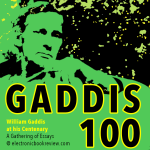fictions present
Gaddis Centenary Roundtable: Para-Academic Venues for Discussing Gaddis and Other Innovative Fiction

This roundtable discussion took place online in August 2023: it has been lightly edited for focus and clarity. The Chair was Ali Chetwynd, with Jeff Bursey, Victoria Harding, Chad Post, Edwin Turner, Chris Via as speakers. More about each participant, including links to their individual projects, can be found in their electronic book review author biographies.
Pre-written Business Correspondences and Computer Therapists: William Gaddis’s J R, ELIZA, and Literacies in Conflict

Rochelle Gold brings Gaddis’s early critique of mid-century capitalism into contact with current criticism by Alan Liu and others, who suggest that humanists must bring their own questions, interests, and values to the table, rather than acquiescing to the economic logic of post-industrialism.
A Student With Mr. Gaddis

Jon Fain studied creative writing with William Gaddis at Bard College between 1976 and 1978, during Gaddis’s first university teaching job. It didn’t go perfectly, as Fain discusses in this retrospective, which includes a letter of Gaddis’s writing-feedback.
The Most Curious Career: William Gaddis in Germany

A personal recitation of Paul Ingendaay's career as a "lifelong" associate editor with the Frankfurter Allgemeine. Ingendaay also shares with us a recollection of the slow, belated but definitive situation of Gaddis's lifework in the German literary canon.
Faire Exchange No Robbery: Critiques of Anthologies and Contracts in an Unpublished Gaddis Play

Written by William Gaddis in the mid-1940s, “Faire Exchange No Robbery” is a short, mock-Elizabethan play in verse, about early poetry anthologies and the death of Christopher Marlowe. Jeffrey Severs brings this unpublished document to light, finding in it the germ of Gaddis’s career-long interests in art’s relationship to commerce, and in the significance of contracts.